Water pollution is exceeding the limit in most of the water sources, and has become a great threat to the survival of aquatic species. An analysis on news of the year 2011 that published in ‘The Daily Star,’ relevant to water pollution, including pollution of both the marine and freshwater especially water of the river, is highlighted in following article.
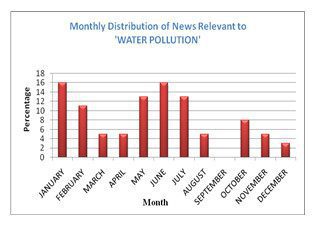
POLLUTION OF THE RIVER WATER:
The rivers of Bangladesh are the worse victim of pollution, especially the rivers which stands in the neighborhood of the Dhaka city is being polluted tremendously.
Causes:
1. Rapid and unplanned urbanization and industrialization, brickfield development, Dying factories, tanneries, Grabbing up the river.
2. The slum dwellers use unhygienic open latrines, wash clothes; take bath even cows and goats bathe in the river.
3. Untreated wastes are thrown into the river as most of the industries have no Effluent Treatment Plant.
According to an industrial survey conducted by Bangladesh Center for Advanced Studies (BCAS) in 2009, only about 40% industries have ETPs. In 10% industries, ETPs are under construction and about 50% industries have no ETP establishment. That is, more than 50% of waste generated by the industries eventually goes to the rivers untreated.
4. Some rivers are used to rot jute plants by the farmers.
5. Oil spills of boats and different water vessel.
6. Using agrochemicals in agricultural land.
Effects:
1. The dissolved oxygen level of many of the rivers’ water has reached at lethal level.
2. Due to over spilling of pollutants during the rainy season, the agricultural lands are contaminated that they have lost their crop growing capacity and hence remain unused all the year round.
3. Sometimes the pollutants enter food chain eventually killing birds, fish, and mammals.
4. The scientists in a recent research on the Karnaphuli found traces of radioactivity ‘very close to risk level’ on the soil. If radioactivity of the river soil goes up it will hamper the natural breeding of fish as well as growth of fishes. If the people eat the affected fish it may spread to their body.
According to the United Nations Scientific Committee on the Effects of Atomic Radiation on 2000 (UNSCER), normal level of radiation hazard due to radioactivity is 0.5. The scientists in their research got 0.6507 for external radiation hazard and 0.82 for internal radiation hazard where the risk level is 1.
5. Pollution is so acute that hardly any hydro-organisms can tolerate it and eventually, fish of many species are found floating dead in the river water. These dead fishes gradually get rotten and highly add to the further pollution of the river water.
6. Due to rotting jute in the river (Chitra) water the water quality of the river is in an inferior position as aquatic creatures are dying for lack of oxygen.
7. The river pollution has also hit the local fishermen hard. Life has become difficult for them as they lost their income source.
8. This also results in the alteration of geomorphic features which can then change in the geometry and sedimentary characteristics of river channels, flood plains and deltas.
9. Industrial pollutants such as lead, cadmium, iron, copper and organic wastes from leaking sewage systems can accumulate in rivers. Referred as bioaccumulation, this process can ruthlessly affect water quality and species survival. More importantly, bioaccumulation of metals in fish, crabs and other edible aquatic species, may cause health problems to enter the food chain. Also, this can destroy the water aeration system, the self-purifying process of rivers.
10. Eutrophication, a process of absorbing excessive nutrients (especially N and P) beyond their buffering capacity of water bodies leads to the loss of species diversity through increased species mortality, changes in species collection and loss of aquatic flora and fauna diversity.
Some steps to minimize pollution in last few years:
There is always a try to minimize pollution. Tongi Industrial Area have unanimously decided for establishing and operating a central ETP with their concerted effort with a view to tackling the Turag River pollution (Prothom-Alo, August 31, 2010). Some projects are initiated to lessen this huge pollution by the government though these all are not effective always.
The government has taken a decision to shift the tannery industry from Hazaribagh to Savar. The water board designed sluice gates on the Jamuna near the Bangabandhu Jamuna Bridge from where the waters would be diverted to the Buriganga.
To save the river from the encroachers and pollution as well as their existence, the sampan majhis organised a three-day sampan khela (boat race) and Chantgaiya (Chittagong) cultural fair in the river Karnaphuli. Sampan Majhi Kalyan Samity Federation (SMKSF) in association with Chattagram Anchalik Sanskriti Academy (CASA) organised the events titled “We are boatmen of the river Karnaphuli and we have pledged to save the river”.
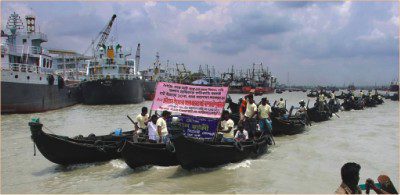
Photo: ANURUP KANTI DAS
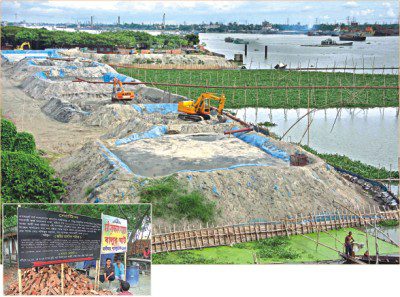
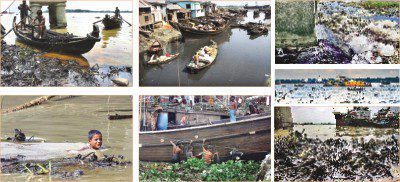
Photo: Anurup Kanti Das
4.4.1.1.4 Discussion:
The most striking reason of pollution river water is the surrounding industries like chemical industries, dying industries, tanneries etc. According to the Environment Conservation Act, 1995 (Amendment 2010), dyeing factories are “red category” industries and are bound to install and run an ETP.
Some other reasons are also liable for water pollution like rotting jute in river water, human wastes, domestic wastes, sand lifting etc. The fish resources and other aquatic resources are being lost from their natural habitat. Fishermen and other people who earn from the river centered activities are being confused and frustrated about their source of income as river water has gone under threat.
While the leather sector brought home hundreds of millions dollars in export earning over the decades, its pollution took its toll on the fish resources, the economic value of which had never been calculated.
The rivers which are closed to the Dhaka city such as Buriganga, Turag, Balu etc. have become more polluted than the others as most of the industries are situated near by these rivers. The slum houses and housing company also worsen the situation.
The pollution spot near the Buriganga Third Bridge experiences huge toxic chemical liquid waste from the Hazaribagh Tannery area through Bashila Khal. There are about 149 tanneries in Hazaribagh which daily generate about 18,000 liters liquid and about 115 metric tones solid waste almost all of which get released into the river Turag through Bashila and Katasur khals. The other extreme pollution spot is near the Tongi Bridge that derives massive pollutant loading from the Tongi Industrial Area. This industrial area possesses about 29 heavy industries. This cluster of industries of the capital city generates 7,159 kg effluents daily (IWM, 2008).
The Institute of Water Modeling (IWM) and the World Bank conducted a survey of pollution in Dhaka Rivers in 2007 that showed there are over 300 various effluent discharge outlets in the capital and Narayanganj.
Most of the rivers, the lifeline of our country, have been polluted severely. If we can’t stop polluting the river now, those rivers will soon become lifeless river. Recent surveys claim that in some parts of polluted river, the level of pollution is so high where in no fish can survive! We, the general people of Bangladesh and other authorities should come forward to save our national asset, our rivers.
The government should inspect whether the etps are operated properly or not because all the industries having ETPs don’t keep them operational all the time; Integrated land and water management approaches towards effective river restoration policy should be implemented without delay; Strict enforcement of the existing environmental policy should be ensured and revised; The slum house should be eradicated from the river bank ensuring the habitation for slum people; Alternative way for waste disposal should be introduced other than the river water and If possible new rules and regulations should be introduced and implemented strictly.
MARINE WATER POLLUTION
Impacts of climate change on marine water are a burning issue in all over the world while pollution through many other activities should be focused.
Causes:
1. Due to the continued high level of CO2 emissions in the atmosphere, seawater chemistry is changing which is causing it to be more acidic. This phenomenon termed as ”ocean acidification”.
2. Ship breaking activities near by the coast also worsen the condition.
3. Accidental or deliberate, operational discharges and spills of oil from ships, especially tankers, offshore platforms and pipelines, are the most obvious and visible causes of oil pollution of the marine environment.
4. Non recyclable wastes that are dumped in the seawater from the nearby sources
4.4.1.2.3 Effects:
Existing Impacts:
1. When wastes are discharged in to the sea can negatively affect biodiversity, food, and human health in coastal areas, oceans and waterways.
2. Consumption of contaminated sea bilge water may contain metals which generally cannot be removed through treatment. Metals, if ingested, can cause various human health problems such as lead poisoning and cancer.
3. As the density of oil is less than water, it floats on the top, forming a thick impermissible membrane which prevents marine organisms to come contact ofsunlight and oxygen, and eventually kills them. As the layer is black and opaque, the sunlight cannot pass through the surface.
This prevents the marine plants from photosynthesizing sunlight into energy. If the constituents of the oil are heavier, then they might sink to the sea floor, blanketing it and thus hindering the marine life over there.
a. Effects on marine wildlife: Sea birds and sea mammals are quite vulnerable to oil spills because they are the most likely of all sea life to run into oil floating on the water.
b. Effects on coastal habitat: A large array of sea species, from marine mammals to sea birds, turtles, fish, crustaceans, and mollusks lose their habitat. Spilled oil and certain cleanup operations can threaten different types of marine habitats in different ways.
Coral reefs are important nurseries for shrimp, fish, and other animals as well as recreational attractions for divers, are at risk from exposure to the toxic substances within oil.
Deposited oil may seep into the muddy bottoms of these tidal flats, creating potentially harmful effects on the ecology of the area. Long-term depletion of sediment life could have an adverse effect on birds or fish that use tidal flats as feeding grounds.
Salt marshes are found in sheltered waters in cold and temperate areas; host a variety of plant, bird, and mammal life. Marsh vegetation, especially root system, is easily damaged by fresh light oils. .
Probable future impacts:
1. Ocean acidification: Amongst the organisms most are threatened by ocean acidification are the shell-building ones such as corals, calcareous plankton (coccolithophores) and algae, molluscs (pteropods, oysters, mussels, clams, etc), echinoderms (sea urchins, starfish, brittle-stars, etc) and some crustaceans.
Ocean acidification, with decrease in pH level, will decrease the availability of carbonate ions (CO3-2) in the water and this ion is very important for these kinds of organisms since it is used for their calcification

Calcification – the process by which these kinds of organisms produce their hard shells and skeletons . The less carbonate ions availability in the water would hamper the calcification, slowing down the growth rates and decreasing the structural strengths of these organisms
Ocean acidification, if not controlled, would exacerbate the situation and could destroy all the coral reefs by as early as 2050. If reefs disappear, many of the reef associated species would face extinction. Consequently, worldwide reef fisheries which provide 9-12% of the world fish landings will collapse. Tourism related to reefs in different countries of the world (at least in about 94 countries) will be stopped as well.
2. Sedimentation: In Bangladesh, coral communities are found only around St. Martin’s Island. Here, a total of 66 coral species have been recorded. They are currently struggling with human pressure and high level of sedimentation, and in near future they are expected to face sea-level rise and increased temperature. If the coral reef disappears, around 86 species of coral reef associated fish recorded from St. Martin’s Island might vanish as well.
3. Sea-level-rise: In tropical regions, low-lying floodplains and associated swamps could be displaced by saltwater habitats due to the combined actions of sea-level rise, more intense monsoonal rains, and larger tidal or storm surges. Saltwater intrusion into freshwater aquifers is also potentially a major problem.
Scientists are concerned with a fact that, everybody anticipates sea-level-rise impact and associated climate change impact on Bangladesh coastal areas. It is already reported that about 18% of Bangladesh’s land will be submerged if the sea-level rises by one meter.
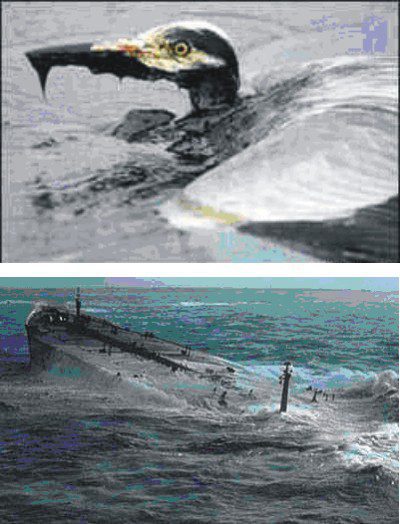
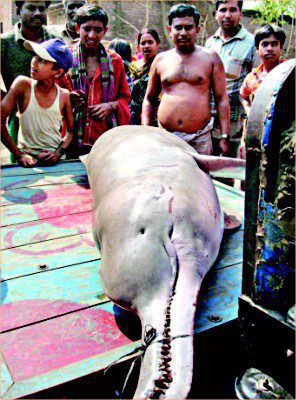
Oil pollution by accident of tanker ship
In Bangladesh, sea-level-rise is colossally affecting coastal areas of the severely affected coastal districts, most affected ones are Satkhira and Bagerhat. Rice cultivation has been reduced by 8 times and shrimp culture practice is increased during the last 10 years in these two districts.
Discussion:
Dumping of bilge from the ship and non recyclable wastages from various sources, ship breaking activities, Ocean acidification due to climate change can be detected as the major causes of marine water pollution.
A report published by the United Nations Environment Program (UNEP) included ship breaking industries in India, Bangladesh and Pakistan among the major land-based sources of marine pollution in the South Asian Seas region.
It was in March 2009 that the High Court issued a directive asking the government to stop unregulated import of scrap ships and formulate rules to ensure scrap yard workers’ safety.
The Supreme Court directive on the government to frame a set of rules by December 14, 2011 to counter escalating hazards posed by ship-breaking industry in Shitakundu is emphatic. The apex court also makes it mandatory for the government to stop conditional import of scrap ships.
The economic necessity of ship-breaking, considering the rising demand of steel, cannot be overemphasized. But the current indiscriminate import of scrap ships is completely unacceptable. This present SC directive should be taken seriously by the government to urgently formulate a new set of rules based on international conventions and other related national laws on environment protection.
On the 20th of December, 2010 an oil spill was detected in the Bay of Sitakunda in Chittagong. It was over 3 kilometers long and 300-400 feet wide with a reddish- black layer. It is suspected that, the cause of the oil spill was the unauthorized transfer or intentional dump of oil into the sea to salvage the grounded Indian flag carrier Ocean Pearl.
Climate change affects all aspects of biodiversity; however, the changes have to take into account concerning the impacts from the past, present, and future human activities, including increasing atmospheric concentration of carbon dioxide. Earth’s mean surface temperature has been projected to warm 1.4 to 5.8º C by the end of the 21st century. Then globally, by the year 2080, about 20% of the coastal wetlands could be lost due to sea level-rise. According to their analysis, unlike global warming and climate change, the major emitters of CO2 are likely to be among those countries most affected by ocean acidification.
The five most vulnerable countries to ocean acidification are – Japan ranking first in the analysis, followed by France, the United Kingdom, the Netherlands and Australia. Among the 187 countries ranked, China and the United States, the world’s top CO2 emitters, rank 13th and 8th respectively, while the rank of Bangladesh is 65.
Until now, most of the studies evaluating impacts of ocean acidification have been carried out in the high latitudes and in the temperate regions since those areas will be affected first. Very few researches have been done to identify the most vulnerable elements of tropical ecosystems. Perhaps no effort has been made so far in Bangladesh as well to identify the threats associated with ocean acidification.
There is no practical solution to this problem except relying on nature to take its course which might take thousands to millions of years for total recovery. Until then the only realistic action we can take is to reduce our global CO2 emissions significantly which will help slow the rate of acidification in the oceans as well. Policy makers need to realize that the measures that only address global warming and climate change are not enough to fully confront global change impacts. Vulnerable countries including Bangladesh need to be concerned about this emerging environmental problem and include ocean acidification alongside climate change in their national action plans and strategies
Coral reefs are home to over 25 percent of all marine life and are among the world’s most fragile and endangered ecosystems. Ocean acidification due to climate change is one of the major causes of coral reef destruction.
Researchers say that, taking into consideration the present condition, if the rate of destruction continues; almost 70% of the world’s coral reef will be destroyed by the year 2050.
Healthy coral reefs mean a healthy world. The Joint Technical Commission for Oceanography and Marine Meteorology (JCOMM) says that “An immediate global response to reduce anthropogenic drivers of climate change is imperative to ensure the survival of these invaluable and diverse ecosystems,”
Bangladesh is a natural laboratory and the place of highest species assemblage as well as species richness in the world, especially the southwestern coastal areas of the country. This area functions both as terrestrial and aquatic ecosystems ensemble. Alternative way should be thought to minimize the future impacts of climate change before reach at extreme level.


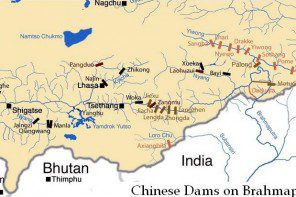
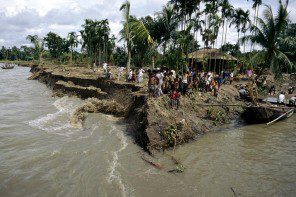
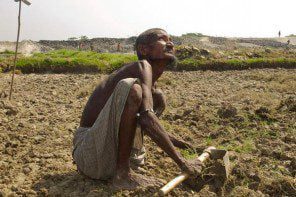

they really don’t care about us.
Treatment of domestic sewage and subsequent utilization of treated sewage for irrigation can prevent pollution of water bodies, reduce the demand for fresh water in the irrigation sector and become a resource for irrigation.